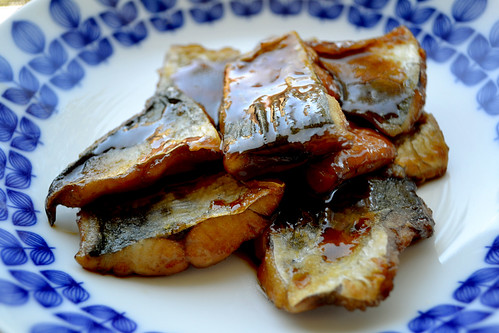
Frying has always been something I was afraid of. I remember my grandma frying whole fish in a huge wok of oil. It took brawn and a fearless attitude toward unpredictable flying specks of oil traveling at high speeds. I will never be half as tough as my grandma, and I still don't have the confidence to buy a gallon of oil and plunge into the world of deep frying.
However, lightly frying and then simmering fish for taste has been a recent trend in the Japanify kitchen. I've been using this technique for saba (mackerel). It's a really simple recipe, which means there is more room for error. I've learned little things from making this several times that avoid sogginess.
I found a Teflon pan in the back of my cupboard that works well for this recipe. Less clean up means more time to enjoy the feast.
Twice-Cooked Saba
INGREDIENTS
1 whole mackerel
1/2 cup flour
Olive oil
Sauce
2 tbsp soy sauce
2 tbsp mirin
3 tbsp sake
1 tsp sugar
METHOD
1. Fillet the fish and cut into 2-inch pieces.
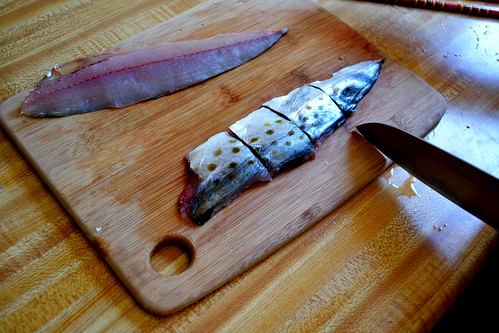
2. Coat each piece with flour.
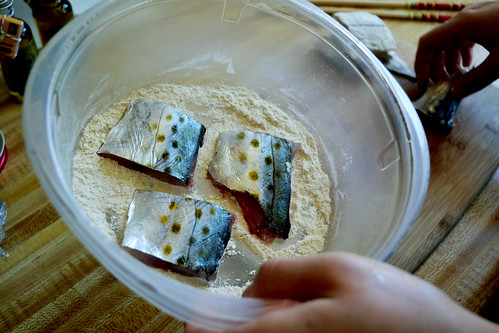

3. Cover a pan liberally with extra virgin olive oil. Set the dial to "high."
4. Once the oil is hot, fry the fish. Make sure the fish is cooked well. Remember that later the fish will be simmered with sauce so to retain the crunch factor, the fish should be fried pretty well. Fry each side.
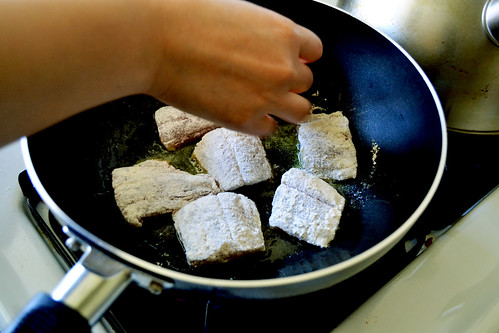
5. After frying, remove the fish from the pan and pat dry the fish. Set aside.
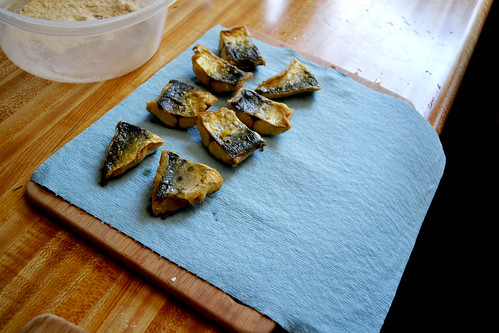
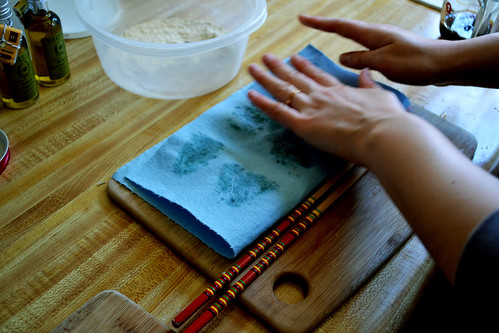
6. Mix together the ingredients for the sauce.
7. Clean out the pan used for frying and put the sauce in the pan. Set the dial to "med-high."
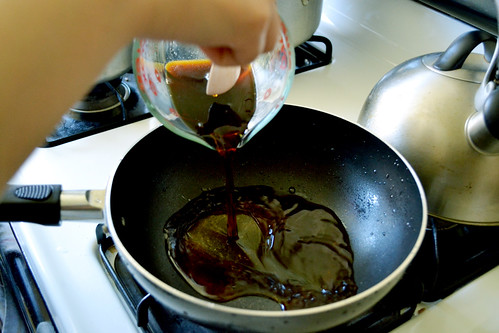
8. Once the sauce heats up, lay the fish pieces into the pan and simmer until the sauce reduces down to half its original amount.

9. Plate and enjoy with some hot steamed rice.
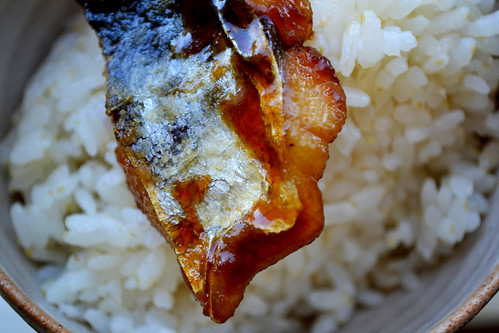
I'll ease into the world of deep frying slowly. I must invest in a splatter screen and build up my confidence gradually, arming myself with gadgets that will reduce the intimidation. I'll master pan frying first to build a friendly relationship with oil as well. For now, I've been pretty pleased with two dishes that deliver the light crisp of frying:
Wakasagi Smelt in Nanban Sauce, and this
saba.
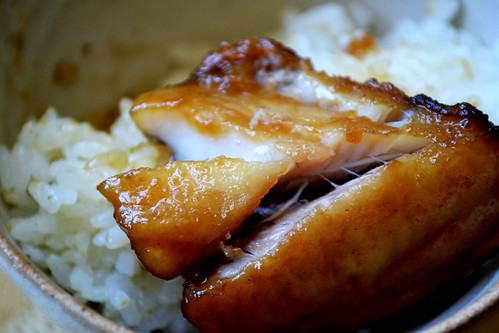
 Frying has always been something I was afraid of. I remember my grandma frying whole fish in a huge wok of oil. It took brawn and a fearless attitude toward unpredictable flying specks of oil traveling at high speeds. I will never be half as tough as my grandma, and I still don't have the confidence to buy a gallon of oil and plunge into the world of deep frying.
However, lightly frying and then simmering fish for taste has been a recent trend in the Japanify kitchen. I've been using this technique for saba (mackerel). It's a really simple recipe, which means there is more room for error. I've learned little things from making this several times that avoid sogginess.
I found a Teflon pan in the back of my cupboard that works well for this recipe. Less clean up means more time to enjoy the feast.
Twice-Cooked Saba
INGREDIENTS
1 whole mackerel
1/2 cup flour
Olive oil
Sauce
2 tbsp soy sauce
2 tbsp mirin
3 tbsp sake
1 tsp sugar
METHOD
1. Fillet the fish and cut into 2-inch pieces.
Frying has always been something I was afraid of. I remember my grandma frying whole fish in a huge wok of oil. It took brawn and a fearless attitude toward unpredictable flying specks of oil traveling at high speeds. I will never be half as tough as my grandma, and I still don't have the confidence to buy a gallon of oil and plunge into the world of deep frying.
However, lightly frying and then simmering fish for taste has been a recent trend in the Japanify kitchen. I've been using this technique for saba (mackerel). It's a really simple recipe, which means there is more room for error. I've learned little things from making this several times that avoid sogginess.
I found a Teflon pan in the back of my cupboard that works well for this recipe. Less clean up means more time to enjoy the feast.
Twice-Cooked Saba
INGREDIENTS
1 whole mackerel
1/2 cup flour
Olive oil
Sauce
2 tbsp soy sauce
2 tbsp mirin
3 tbsp sake
1 tsp sugar
METHOD
1. Fillet the fish and cut into 2-inch pieces.
 2. Coat each piece with flour.
2. Coat each piece with flour.

 3. Cover a pan liberally with extra virgin olive oil. Set the dial to "high."
4. Once the oil is hot, fry the fish. Make sure the fish is cooked well. Remember that later the fish will be simmered with sauce so to retain the crunch factor, the fish should be fried pretty well. Fry each side.
3. Cover a pan liberally with extra virgin olive oil. Set the dial to "high."
4. Once the oil is hot, fry the fish. Make sure the fish is cooked well. Remember that later the fish will be simmered with sauce so to retain the crunch factor, the fish should be fried pretty well. Fry each side.
 5. After frying, remove the fish from the pan and pat dry the fish. Set aside.
5. After frying, remove the fish from the pan and pat dry the fish. Set aside.

 6. Mix together the ingredients for the sauce.
7. Clean out the pan used for frying and put the sauce in the pan. Set the dial to "med-high."
6. Mix together the ingredients for the sauce.
7. Clean out the pan used for frying and put the sauce in the pan. Set the dial to "med-high."
 8. Once the sauce heats up, lay the fish pieces into the pan and simmer until the sauce reduces down to half its original amount.
8. Once the sauce heats up, lay the fish pieces into the pan and simmer until the sauce reduces down to half its original amount.
 9. Plate and enjoy with some hot steamed rice.
9. Plate and enjoy with some hot steamed rice.
 I'll ease into the world of deep frying slowly. I must invest in a splatter screen and build up my confidence gradually, arming myself with gadgets that will reduce the intimidation. I'll master pan frying first to build a friendly relationship with oil as well. For now, I've been pretty pleased with two dishes that deliver the light crisp of frying: Wakasagi Smelt in Nanban Sauce, and this saba.
I'll ease into the world of deep frying slowly. I must invest in a splatter screen and build up my confidence gradually, arming myself with gadgets that will reduce the intimidation. I'll master pan frying first to build a friendly relationship with oil as well. For now, I've been pretty pleased with two dishes that deliver the light crisp of frying: Wakasagi Smelt in Nanban Sauce, and this saba.





Comments (8)
Wow, oishiso! And it looks so easy too.
hey, great! i’ll have to try this out soon. the only way i’ve ever cooked saba is via the broiler.
Saba in a broiler sounds delicious! Do you season it with salt or soy sauce?
I’m gonna make this tonight for friends! I had saba yesterday and it tastes slightly too canned fish for me (and too many bones even when bought fileted), so I might use another species than saba. But I like the cook-after-fry technique.
Yoko, this was deliriously delicious! I bought plaice fillets instead which worked really well – more neutral in taste to the flavours of the sauce came through very well. My guests loved it.
I am so glad it worked out for you. It was easy right? I hope it becomes a part of your menu at your apt.
Hi Yoko – Thanks for recommending using a Teflon® non-stick pan while making your Twice-Cooked Saba. I represent DuPont and it’s always a pleasure to see people recommending our products in their recipes.
If you are interested in some other recipes or great cookbooks to look at for your blog, drop me an email and I would be glad to help you out! Thanks. Cheers, Sara
Everything is good with teriyaki sauce.Uhmm deliciouss